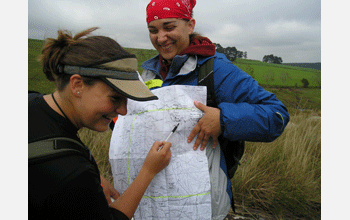Multimedia Gallery
REU Glacial Studies (Image 1)
REU Glacial Studies (Image 1)
Glacial deposits and inter-bedded, non-glacial maps are mapped on topographic base maps during a research study of comparative analysis of glacial sediments in Minnesota and Brazil.
The research work was led by James Cotter, a professor of geology at the University of Minnesota, Morris (UMM), and was conducted as part of a National Science Foundation Research Experiences for Undergraduates (REU) program project where eight women were involved in field and laboratory research. The project was a collaborative effort between UMM and Universidade de Sao Paulo (USP).
The research in Brazil involved detailed mapping of glacial units in the Witmarsum area, Parana state. Results of the mapping--conducted by REU participants--indicate that glacial deposits are more abundant; that several different glacial facies are present; and that more exposure of unique features like striated pavements are present. In western Minnesota, research focused on the deglacial history of the Des Moines lobe. Studies of Glacial Lake Benson, a lake that formed prior to Lake Agassiz, indicate that it was indeed a pro-glacial lake but it may have been both more extensive to the northwest, and longer in extent then envisioned. Studies of new outcrops on or near the big Stone Moraine suggest that Lake Agassiz may have formed soon after the draining of Glacial Lake Benson.
Academic activities included introductory lectures, seminars, fieldwork, lab work and computer applications. At the end of the project, all REU participants submitted abstracts to the North Central Section Meeting of the Geological Society of America and presented posters there. Further information about the REU Program is available Here. (Date of Image: July 2005) [Image 1 of 3 related images. See Image 2.]
Credit: James Cotter, UM Morris
Images and other media in the National Science Foundation Multimedia Gallery are available for use in print and electronic material by NSF employees, members of the media, university staff, teachers and the general public. All media in the gallery are intended for personal, educational and nonprofit/non-commercial use only.
Images credited to the National Science Foundation, a federal agency, are in the public domain. The images were created by employees of the United States Government as part of their official duties or prepared by contractors as "works for hire" for NSF. You may freely use NSF-credited images and, at your discretion, credit NSF with a "Courtesy: National Science Foundation" notation.
Additional information about general usage can be found in Conditions.
Also Available:
Download the high-resolution JPG version of the image. (1.3 MB)
Use your mouse to right-click (Mac users may need to Ctrl-click) the link above and choose the option that will save the file or target to your computer.

